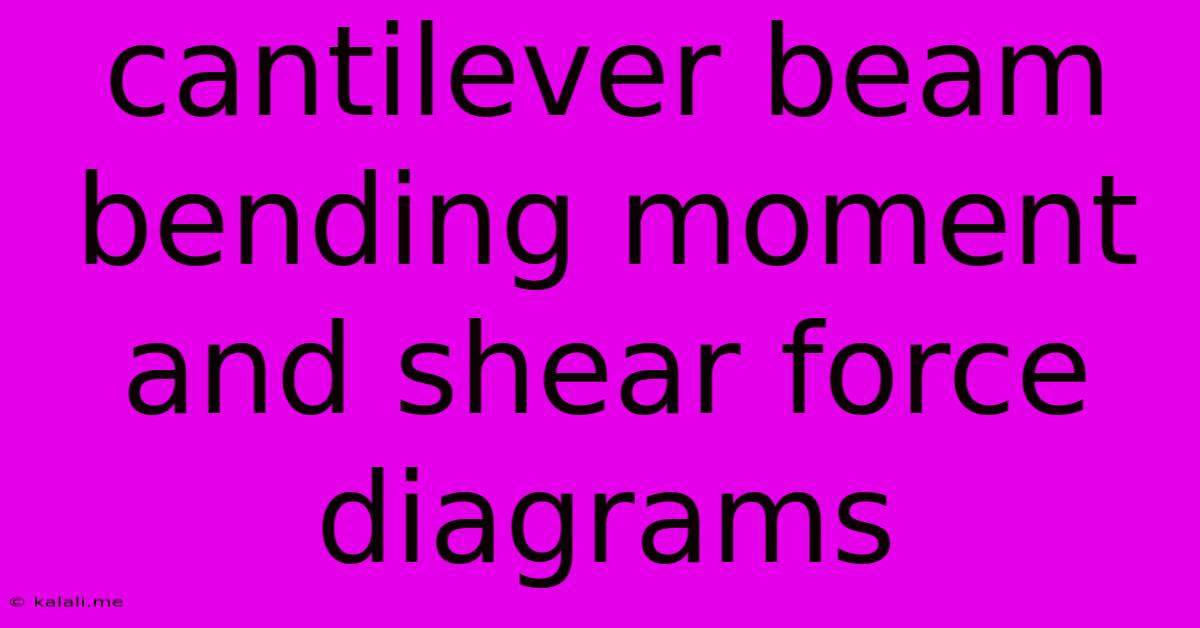Cantilever Beam Bending Moment And Shear Force Diagrams
Kalali
Jun 12, 2025 · 4 min read

Table of Contents
Understanding Cantilever Beam Bending Moment and Shear Force Diagrams
Understanding cantilever beam bending moment and shear force diagrams is crucial for any structural engineer or engineering student. This article will provide a comprehensive guide to constructing and interpreting these diagrams, covering key concepts and practical applications. We'll explore how to calculate shear force and bending moment values, and how to visually represent them to understand the stresses within the beam.
What is a Cantilever Beam?
A cantilever beam is a structural element fixed at one end and free at the other. This fixed end provides support and reaction forces, while the free end is subjected to external loads. This configuration leads to unique bending moment and shear force distributions compared to other beam types like simply supported beams. Examples include balconies, diving boards, and overhanging structures.
Understanding Shear Force and Bending Moment
Before diving into diagrams, let's define these crucial concepts:
- Shear Force: This is the internal force acting parallel to the cross-section of the beam, resulting from external loads. It represents the tendency of the beam to shear or slide along a plane.
- Bending Moment: This is the internal moment (a rotational force) acting on the cross-section of the beam, causing it to bend. It is the sum of all the moments acting on the beam up to a given point.
How to Construct Shear Force and Bending Moment Diagrams
The process involves systematically analyzing the beam under the influence of external loads and reactions. Here's a step-by-step approach:
-
Determine Reactions: Begin by calculating the reactions at the fixed support. For a cantilever beam with a point load (P) at the free end, the reaction force (R) at the fixed end will be equal and opposite to P (R = P), and the reaction moment (M) will be equal to P multiplied by the length (L) of the beam (M = PL).
-
Calculate Shear Force: Move along the beam, analyzing the shear force at each section. For a cantilever beam with a point load at the free end, the shear force is constant and equal to the reaction force (R) from the fixed support. It remains constant until the point load is encountered. For uniformly distributed loads (UDL), the shear force varies linearly.
-
Calculate Bending Moment: Similarly, move along the beam and calculate the bending moment at each section. For a cantilever beam with a point load at the free end, the bending moment varies linearly, starting at zero at the free end and reaching a maximum value (PL) at the fixed end. For a UDL, the bending moment varies quadratically.
-
Draw the Diagrams: Plot the calculated shear force and bending moment values along the length of the beam. The shear force diagram shows the variation of shear force along the beam length, and the bending moment diagram shows the variation of bending moment.
Interpreting the Diagrams
The diagrams provide crucial information about the beam's internal forces and stresses:
- Maximum Shear Force: Indicates the location where the beam experiences the highest shearing stress.
- Maximum Bending Moment: Indicates the location where the beam experiences the highest bending stress. This is critical for determining the beam's capacity and preventing failure. The maximum bending moment usually occurs at the fixed support for a cantilever beam.
- Points of Zero Shear Force: These points often correspond to locations of maximum or minimum bending moment.
Common Load Cases and their Diagrams
Here are some common load cases and their corresponding shear force and bending moment diagrams:
- Point Load: The shear force diagram is a step function, and the bending moment diagram is a linear function.
- Uniformly Distributed Load (UDL): The shear force diagram is a linear function, and the bending moment diagram is a parabolic function.
- Concentrated Moment: The shear force diagram is unaffected, while the bending moment diagram shows a step change at the point of the applied moment.
Conclusion
Understanding cantilever beam bending moment and shear force diagrams is fundamental to structural analysis. The ability to accurately construct and interpret these diagrams allows engineers to determine the stresses within a beam, ensuring its stability and safety under various load conditions. Mastering this skill is essential for designing safe and efficient structures.
Latest Posts
Latest Posts
-
Which Of The Following Is An Igneous Rock
Jun 13, 2025
-
The Molten Rock Inside The Earth Is Called
Jun 13, 2025
-
Which Planet Is The Least Dense
Jun 13, 2025
-
What Is The Factors Of 144
Jun 13, 2025
-
If X 0 Then X Is Equal To
Jun 13, 2025
Related Post
Thank you for visiting our website which covers about Cantilever Beam Bending Moment And Shear Force Diagrams . We hope the information provided has been useful to you. Feel free to contact us if you have any questions or need further assistance. See you next time and don't miss to bookmark.